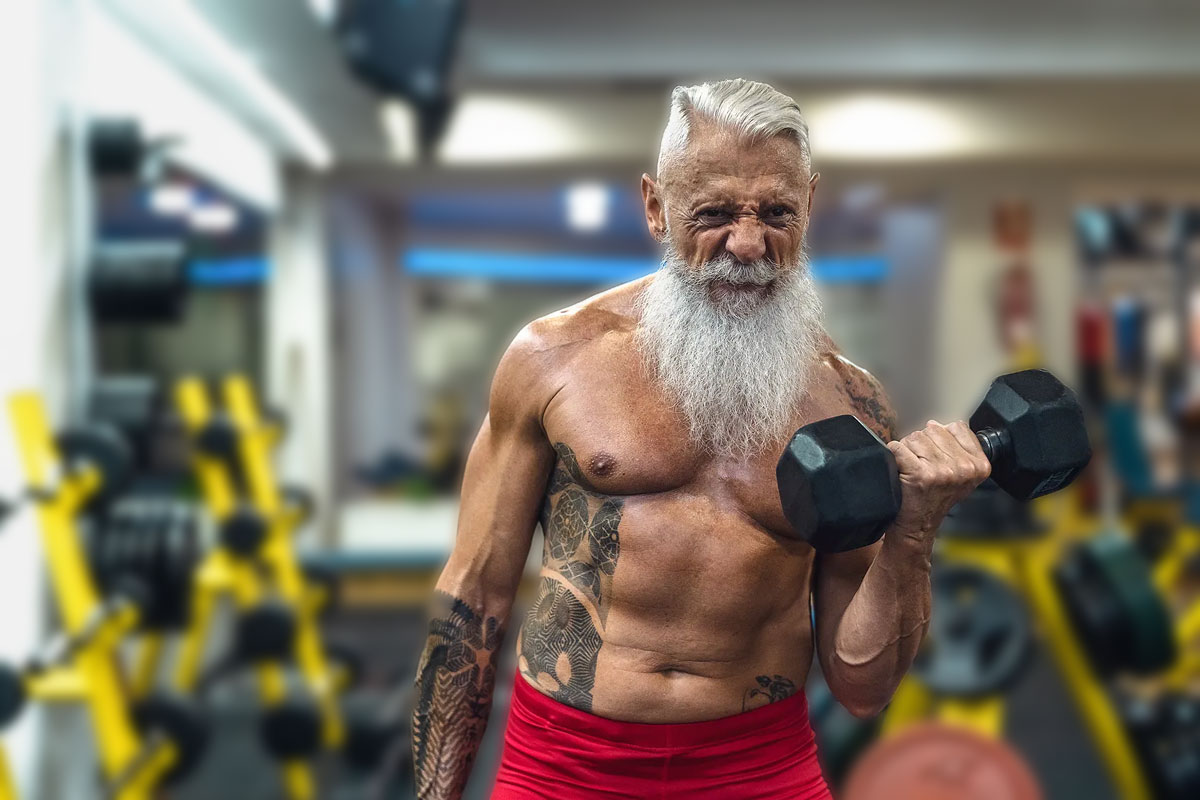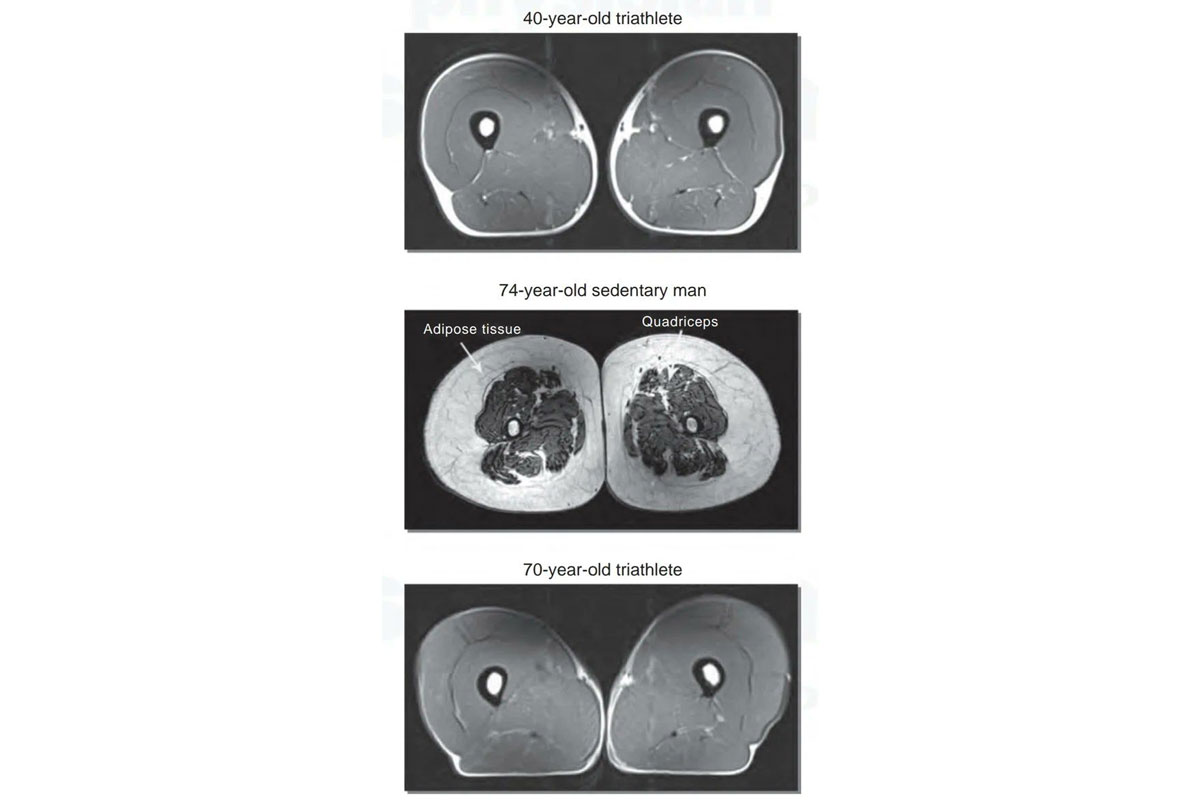
Despite plenty of evidence and honest accounts, keeping fit in older age probably isn’t something many people feel they can do or indeed, want to do. But some X-rays DMARGE has come across provide damning evidence to suggest even an 80 year old man can be stronger than a 30 year old if they commit to getting fit.
The X-rays, or more specifically, MRI scans, in question were posted to LinkedIn by body transformation coach, Dan Go. In his post, Dan places three MRI scans side by side, which show the upper leg of a 40 year old triathlete, a 74 year old sedentary man and a 70 year old triathlete.
Dan explains, “the dark part around the bone is muscle. The white part is fat.”

If you’re not entirely sure exactly what you’re looking at, Dan further explains, “what you’ll see in this picture is that the 40 year old and 70 year old have the same amount of muscle in their bodies, while the 74 year old sedentary man does not (obviously)”
“Studies show that an 80 year old who lifts weights is stronger than a 30 year old man who doesn’t. What you should take from both of these examples is that you either use it or lose it.”
Dan Go
We’re certainly inclined to agree. It makes sense, of course, if you lift weights no matter your age, you’re going to be stronger than someone who barely lifts a finger. But, while this evidence is clear, there are still some things you should be conscious of, if you do plan to remain a literal lifelong member of your gym.
Ben Lucas, former NRL player, owner of Flow Athletic and a man who has maintained a strict fitness regime since retiring, which sees him running the New York Marathon in November with Athletes For Life, has spoken to DMARGE about the benefits (and potential risks) of keeping fit as you age.
Speaking to Dan’s point about an 80 year old who lifts being stronger than a 30 year old who doesn’t, Ben said “there is always an exception to the rule.”
“This is mainly due to genetics, but in general, our muscles, strength and their function starts to decline as we age. Research has shown that from the age of 30, your muscle mass will decrease by 3-8% per decade and the rate of decline gets steeper after 60.”
“This means that it is important to keep doing some form of resistance training as we age, especially for the health of your bones as osteoporosis is prevalent in Australia.”
“Can you be stronger than a 30 year old who has never lifted in their life? Possibly. But it is not a necessary benchmark to set yourself.”
So, while you could be stronger than a Gen Z with a disposition for Netflix and McDonald’s, it’s not necessarily a guarantee. Ben also says you should adjust your training plan to suit your age. It’s unlikely you’re going to be a real life Superman, after all.
“At 60, I would be more working out to improve mobility and to maintain your muscle mass best you can, as that is what matters to you at that age. Squatting 100kg is not really helping your mobility and it may lead to an injury. You’re going to be better off doing some functional movements to keep yourself mobile, rather than potentially injuring yourself.”
One user did comment on Dan’s post, saying, “the actual wear and tear on that 70 year old athlete’s body and joints can be just as dilapidating, as many are now having hip and joint replacements alongside severe arthritis.” We presume, from this comment, the user means the force placed upon older joints can be just as detrimental as a younger person doing no exercise at all.
To this, Ben tells DMARGE, “Pain due to various ailments are all depending on perspective of the individual. Anything that causes them pain or stops them from being able to do what they enjoy pain-free wouldn’t be great. To minimise the effects of training on joints as you age, I would suggest the following:”
- Be mindful of plyometric movements, as they can be heavy on your joints
- If you have niggles, work with a trainer if you are not confident in the weights room, who can help you
- Make sure you maintain good posture and good form when you are doing your exercises as bad posture can cause joint problems
- Consider getting a massage or seeing a physiotherapist if you have a problem area
- Your diet and the amount of sleep you are getting is also important. Lean protein, whole foods, antioxidants and lots of water are all important
- Be active
- Do some resistance training for the integrity of your muscles and your bones
Heath Jones, Director of the Active & Ageless Over 50s Club has also previously spoken to DMARGE about staying active as you get older. He told us the majority of exercise he sees the older generation carrying out is cardio-based, things like tennis, swimming and walking. But he said there is always still room for strength training,
“Strength and mobility as we age is absolutely paramount if a person wants to lead a good quality of life well into their later years. By having good levels of strength and mobility we are able to perform daily activities safely and effectively.”
“Training, particularly as we age, should be focused more to the movement of the exercise as opposed to aesthetically on the size of the muscle. For example, in an exercise routine, instead of doing a bicep curl, we can include a bicep curl to press.”
The takeaway? Any form of exercise, no matter how old you are, is going to be better than doing no exercise at all (this isn’t rocket science, remember?). It’s also important to train within your means. Yes, you may have a seriously determined mindset which encourages you to train to your absolute optimum, but you also need to factor in the natural biology of life.
If your body can’t realistically handle the level of training you want to carry out, then listen to it. We don’t all have to look like Terry Crews.
Read Next- 64-Year-Old Man’s Stunning Workout Proves Age Really Is Just A Number
- “Why Wouldn’t You?” Australian Men Reveal The Real Reasons They Go To The Gym
The post Eye-Opening X-Rays Proof It Pays To Stay Active In Old Age appeared first on DMARGE.
0 Commentaires